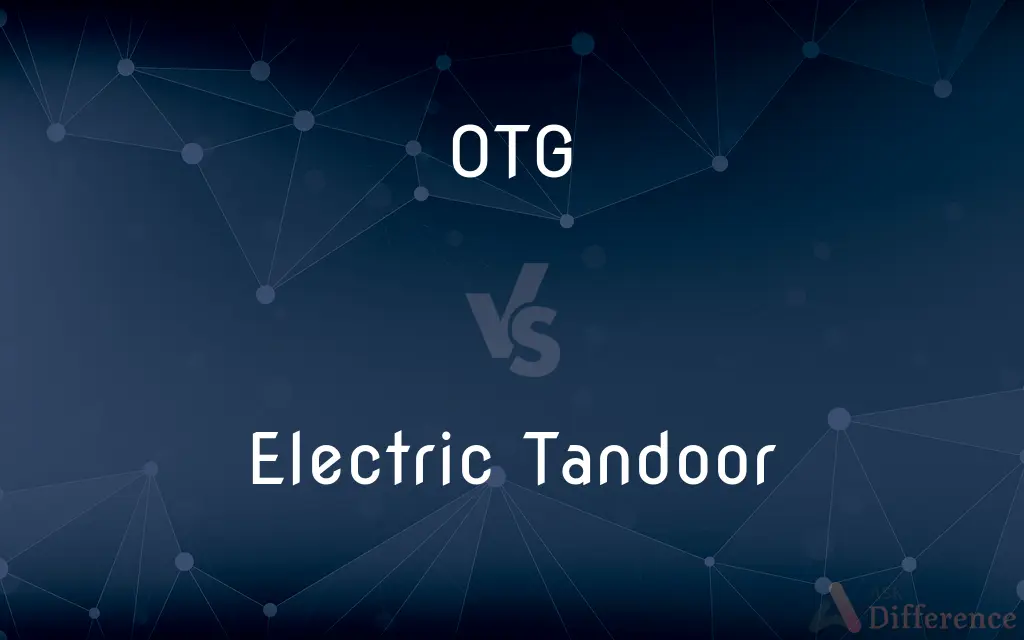OTG vs. Electric Tandoor — What's the Difference?
Edited by Tayyaba Rehman — By Fiza Rafique — Published on November 6, 2023
OTG (Oven-Toaster-Griller) is a versatile kitchen appliance for baking, toasting, and grilling, while an Electric Tandoor is specifically designed for tandoori cooking using electric heating.

Difference Between OTG and Electric Tandoor
Table of Contents
ADVERTISEMENT
Key Differences
The OTG and Electric Tandoor are both essential kitchen appliances but serve different culinary needs. While OTG, an abbreviation for Oven-Toaster-Griller, is multifunctional and caters to a variety of cooking methods, the Electric Tandoor is specialized for tandoori-style dishes.
OTGs offer versatility, allowing users to bake cakes, toast bread, and even grill vegetables or meat. They operate using heating elements present at the top and bottom, which can be controlled individually or together. In contrast, the Electric Tandoor uses electric coils to generate heat, replicating the intense heat of traditional clay tandoors.
For those who love baked goods like cakes, cookies, and pastries, the OTG is an ideal choice as it provides even heat distribution essential for baking. On the other side, the Electric Tandoor is perfect for those who cherish tandoori rotis, kebabs, and other grilled delicacies typical of Indian cuisine.
One of the significant differences between an OTG and an Electric Tandoor lies in their construction and design. While OTGs resemble small ovens with temperature controls, timers, and multiple racks, Electric Tandoors have a flatter, often open design, mimicking the shape and function of traditional tandoors.
While both the OTG and the Electric Tandoor use electricity to function, their power consumption might vary. OTGs, due to their multifunctionality, may consume more power, while Electric Tandoors, being single-purpose, might be more energy-efficient for tandoori cooking.
ADVERTISEMENT
Comparison Chart
Primary Use
Baking, Toasting, Grilling
Tandoori cooking
Heating Element
Top & Bottom heating elements
Electric coils
Versatility
Multifunctional
Specialized
Design
Oven-like with racks and door
Flatter, open design
Temperature Control
Adjustable with specific temperature range
Generally high heat, fewer temperature settings
Compare with Definitions
OTG
OTG is equipped with temperature controls and timers.
I set the OTG at 180°C for 30 minutes to bake my cookies.
Electric Tandoor
Electric Tandoor often has a flat, open design.
The open design of the Electric Tandoor allows me to monitor the cooking process closely.
OTG
OTG is a compact electric oven used for baking, grilling, and toasting.
I baked a chocolate cake in my OTG for my son's birthday.
Electric Tandoor
Electric Tandoor is an appliance designed for tandoori-style cooking.
I made some delicious kebabs in my Electric Tandoor last night.
OTG
OTG uses heating elements usually at the top and bottom.
I turned on only the top element of the OTG to grill the chicken.
Electric Tandoor
Electric Tandoor replicates the high heat of traditional clay tandoors.
Tandoori rotis from the Electric Tandoor tasted as authentic as the ones from a clay tandoor.
OTG
OTG is a versatile kitchen appliance suitable for various cooking needs.
From baking pies to grilling skewers, my OTG does it all.
Electric Tandoor
Electric Tandoor uses electric coils for heating.
The electric coils in my Electric Tandoor heat up quickly, making it efficient.
OTG
OTG incorporates both oven and toaster functionalities.
After baking muffins in the OTG, I used it to toast some bread.
Electric Tandoor
Electric Tandoor is specifically designed for grilling and roasting.
My Electric Tandoor is perfect for making grilled paneer and roasted vegetables.
Common Curiosities
Which is better for baking cookies, OTG or Electric Tandoor?
An OTG is more suitable for baking cookies due to its even heat distribution.
What does OTG stand for?
OTG stands for Oven-Toaster-Griller.
Can I toast bread in an OTG?
Yes, you can toast bread in an OTG using its toasting function.
How does an Electric Tandoor heat up?
An Electric Tandoor uses electric coils to generate intense heat.
Is the Electric Tandoor suitable for baking cakes?
While primarily for tandoori cooking, some Electric Tandoors might support baking, but OTGs are more suitable for that purpose.
Is OTG suitable for Indian dishes?
Yes, OTGs can be used for various Indian dishes, including baking and grilling.
What's the main difference between OTG and Electric Tandoor?
OTG is versatile for baking, toasting, and grilling, while Electric Tandoor is specialized for tandoori cooking.
Are Electric Tandoors energy-efficient?
Generally, Electric Tandoors are energy-efficient for tandoori cooking due to their specific purpose design.
Is the Electric Tandoor similar to traditional tandoors?
Electric Tandoor mimics the high heat of traditional clay tandoors but uses electric coils.
Which is more versatile, OTG or Electric Tandoor?
OTG is more versatile, catering to baking, toasting, and grilling, while Electric Tandoor is more specialized.
How do I clean an Electric Tandoor?
Most Electric Tandoors have removable trays or grates, which can be cleaned with regular dishwashing methods.
Can I make pizza in an OTG?
Yes, you can bake pizza in an OTG.
Which appliance is better for grilling vegetables, OTG or Electric Tandoor?
Both can grill vegetables, but the Electric Tandoor might offer a more authentic grilled flavor.
How does an OTG regulate temperature?
OTGs have adjustable temperature controls, usually with a specific temperature range.
Can I roast chicken in an OTG?
Yes, you can roast chicken in an OTG using its grilling function.
Share Your Discovery

Previous Comparison
Advertising vs. Personal Selling
Next Comparison
Front Office Executive vs. ReceptionistAuthor Spotlight
Written by
Fiza RafiqueFiza Rafique is a skilled content writer at AskDifference.com, where she meticulously refines and enhances written pieces. Drawing from her vast editorial expertise, Fiza ensures clarity, accuracy, and precision in every article. Passionate about language, she continually seeks to elevate the quality of content for readers worldwide.
Edited by
Tayyaba RehmanTayyaba Rehman is a distinguished writer, currently serving as a primary contributor to askdifference.com. As a researcher in semantics and etymology, Tayyaba's passion for the complexity of languages and their distinctions has found a perfect home on the platform. Tayyaba delves into the intricacies of language, distinguishing between commonly confused words and phrases, thereby providing clarity for readers worldwide.












































